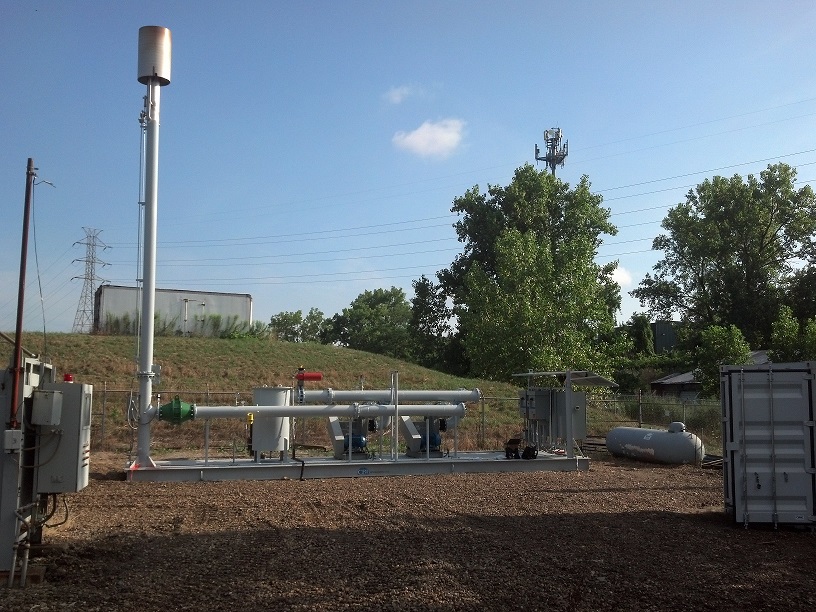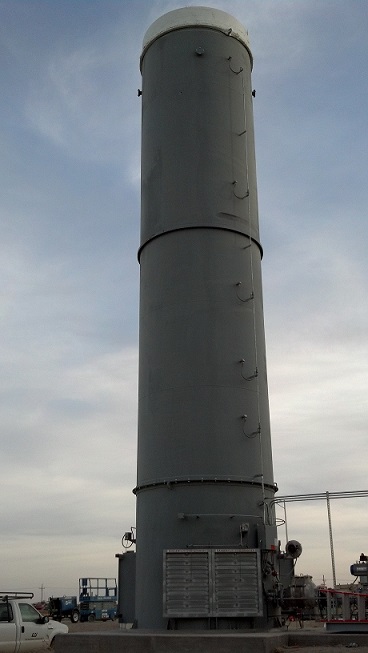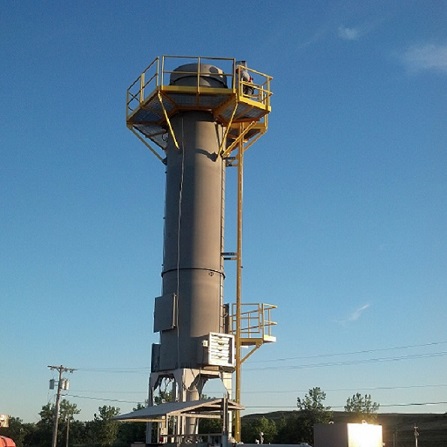Utility Flare

This type of flare has an open burner set at a suffcient elevation to limit the amount of radiated heat that reaches the ground. They have good combustion effciency but all other types flare have verifiable and better destruction effciency.
Due to open combustion this type of flare is difficult to accurately measure emmissions and destruction efficency.
The greatest advantage to this type of flare is the low price and maintenance as compared to other types of flares.
Some other names for this type of flare are...
Elevated, Candle Stick and Open Flare
Utility flares give the best destruction effciency and lowest cost of ownership for the price.
Flare Guy
Qualities
Simplest of landfill gas flares
Low maintenance
Smallest equipment footprint
Must consider location from power lines and buildings due to the open flame
Lowest cost of landfill gas flares
When used in passive operation, nearly no energy consumption for burner operation
Good desruction effciency but lower than other technologies
Preferred technology when strict emission are not a requirement
Cannot directly measure emissions
Open / Visible flame
Enclosed Flare

This style of flare stack encloses the combustor and incorporates air dampers.
Enclosing the combustion process retains heat from burning landfill gas affording additional time to destroy combustion byproducts. Draft is induced by the difference in air pressure from the top to bottom of the stack. Dampers providing a method for excess air regulation or temperature control.
Heat released in the reaction between oxygen in air and methane in landfill gas results in a rise of temperature in the stack. The heat reduces the air density inside the enclosed space. The rising mass of heated air further reduce the pressure in the stack increasing the draft necessitating the need for air flow control. Adjustment of the dampers allow regulation of combustion temperature and help set emission from the stack. Combustion constituents created during combustion are dependent on the temperature, oxygen, and the time retained in the stack heat zone.
Destruction efficiency is improved by retention of combustion byproducts in the heat zone created inside the stack. In addition to providing retention time, stack exhaust can be sampled for emission verification. Flares from this family can provide destruction efficiency up to 99.9% with reasonable NOX and CO emissions.
The empirical operating point for flares of this class is 1650°F (900°C). Combustion of landfill gas at this temperature provides the lowest emissions between CO and NOX, emission that have an important impact on air quality.
Reduce the temperature CO increases, increase it and NOX goes up. Some
variation in set point is likely due to emission requirements, flare
burner performance, measurement technique, measurement location and
electronics accuracy. Therefore, emission testing is required to confirm the
correct temperature set point to obtain the desired emission.
Enclosed flares provide the best performance to minimize NOX and CO for the price.
Flare Guy
Qualities
No visible flame / smoke
Verifiable emissions
Low energy consumption for burner operation
Controllable emission spectum within the performance of the burner
Added complexity of air damper control
Emission quality is dependent on flame position, control loop tuning / temperature stability
Moderate cost
Larger footprint than utility flares
Ultra Low Emission Flares

This class of landfill gas flares offer the lowest emissions and greatest destruction effciency at the cost of energy consumption, sophisticated control algorithms and complex burner design.
Low emission flares are forced draft to insure tight control of the oxidizer and fuel. Forced draft flares use an air blower to deliver air.
Air and landfill gas are mixed in a vessel to insure an even distibution of fuel and air at the burner. The burner nozzle provides a final point of mixing or diffusion to insure the best possible mix of air and fuel prior to combustion.
Although air is tightly controlled during premix burners are not perfect and some hydrocarbons may escape primary combustion at the burner.
Hot combustion gases retained in the stack are afforded additional time to completely combust anything that did not break down during primary combustion.
Secondary air introduced at the stack in the same way it is done with a natural draft enclosed flare introduces additional air for oxidation of any gas not destroyed at the burner. An added benefit of secondary air is to llimit stack temperature, extending insulation life.
Another consideration to be made is premixed fuel and air are ready to combustion and can result in an explosition if not properly handeled. To better manage risk the amount of premixed fuel should be kept to the smallest amount possible limiting the explosive power at any instant during regular operation
Ultra-Low Emission Flares offer the best emmission performance under the most stringent regulatory requiements at the cost of energy consumption, equipment cost, complexity and maintenance.
Flare Guy
Qualities
Lowest emission
Highest destruction efficiency
Highest energy comsumption
Greatest complexitiy
Greater maintenance cost
Largest equipment foot print
Highest price